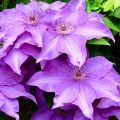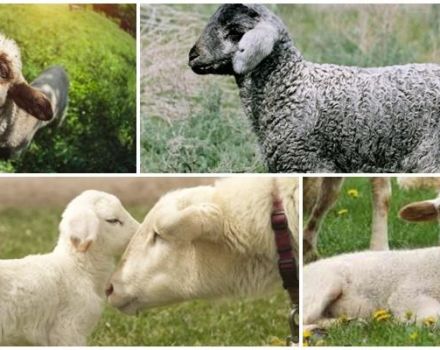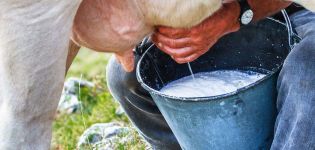Description and varieties of grape-leaved clematis, cultivation features
The grape-leaved clematis has small inflorescences, which are arranged in lush clusters, which creates an attractive appearance. Proper care not only increases the flowering of the shrub, but also allows you to create compositions with other types of plants to decorate the garden area.
Description and features
Clematis is a climbing plant. This variety can be up to 25 meters long. Vines can curl around hedges or nearby trees. The bushes bloom in mid-July until the first frost. The plant can be herbaceous or bushy. The difference is that the herbaceous plant dies off in the fall, only the root hibernates. Clematis got its name from the fact that vines can curl like vines. The leaves are round, pointed. Inflorescences no more than 2 cm in diameter.
Features:
- small-flowered clematis is resistant to diseases;
- inflorescence color is white;
- in one season it can reach large sizes;
- flowers are asexual;
- buds are formed only on young shoots.
During flowering, the flowers are collected in a brush and emit a slight almond scent.
Landing
Culture tends to grow in any kind of soil. However, the intensity of flowering and the development of culture depend on the correctly selected planting site.
Seat selection
The bush prefers plenty of sunlight. Therefore, it is planted in places where the sun's rays hit the bush for at least 6-7 hours a day. Also, the landing site should be protected from drafts and wind.
Important. The planting site should not be sultry, otherwise burns may form on the leaves..
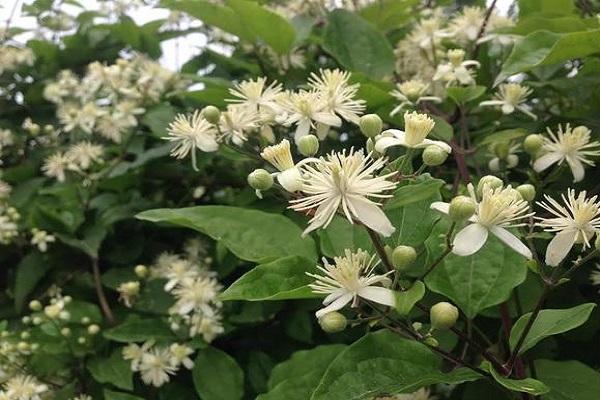
Soil requirements
The plant grows in aerial soils that contain organic fertilizers. The soil should be moist, but in moderation, otherwise putrefactive processes in the roots may form, and the plant will die.
Timing
Planting clematis should be carried out in mid-September, before the first frosts, the plant will have time to get stronger and survive low temperatures. If necessary, clematis seedlings can be planted in mid-April under cover.

Landing scheme
Before planting, it is necessary to prepare a nutrient mixture for planting the seedling in open ground. To do this, mix 2 parts of humus, part of the soil and part of the sand. Also, a pinch of lime must be added to the composition to reduce acidity.
Planting clematis is done according to the following method:
- dig a hole 40 cm;
- drainage is placed at the bottom of the pit;
- the soil fits into a hill-shaped hole;
- the seedling is placed in a hole and dug in to a depth of 15 cm;
- the seedling is watered and mulched with a layer of sawdust on top.
If there is a decrease in air temperature at night, the seedling must be covered.
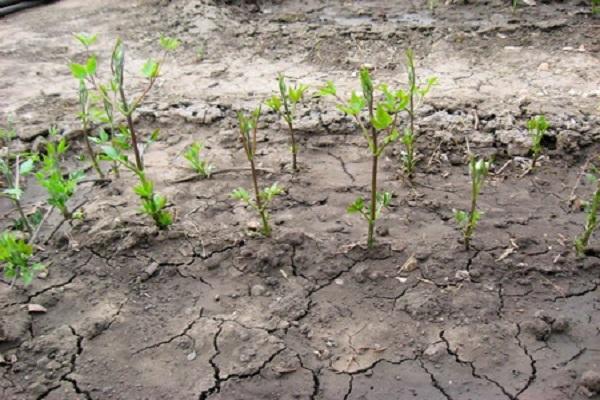
Care
In order for the seedling to quickly begin to develop, it is necessary to observe regular care and timely fertilization.
Watering
Watering should be done every three days. One bush should take at least 1 bucket of water. In order to retain moisture, a layer of mulch must be used.
Loosening and weeding
The soil is loosened to improve the penetration of oxygen into the soil, the procedure must be carried out regularly before watering. Weed removal is carried out as needed.
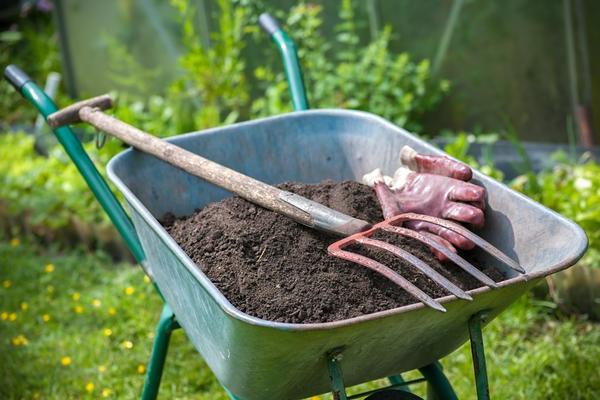
Top dressing
Fertilization must be carried out according to the following scheme:
- spring - nitrogen fertilizers and chicken droppings are applied;
- before the formation of buds, it is necessary to apply phosphorus and potash fertilizers to increase the formation of inflorescences;
- complex fertilizers are used twice during the summer;
- in the fall, mullein and humus are introduced.
Different types of fertilizers must be used with an interval of at least 10 days between dressings.
Trimming group
Clematis belongs to the 3rd group of pruning. Vines are pruned twice a year, in autumn and early spring, before budding. Summer pruning can also be used to create the desired shape.
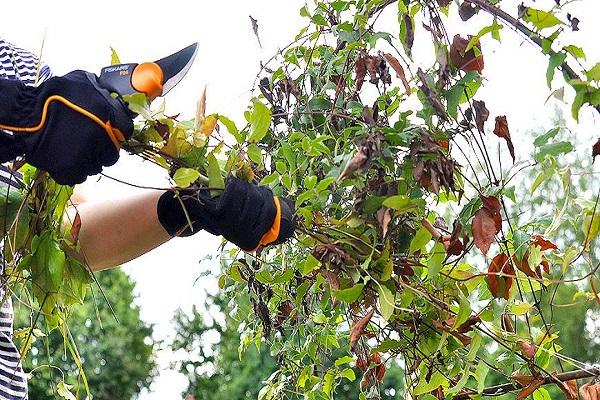
Protection against diseases and pests
The plant is resistant to diseases, but the following problems may arise:
- Rust - appears in the form of spots on the leaves. The infection spreads quickly and can infect a bush in a short time. For treatment, copper sulfate or special spray preparations are used. The damaged areas must be removed.
- Root rot - occurs as a result of excessive moisture levels in the soil. To eliminate the problem, it is necessary to regularly loosen the soil and follow the watering rules.
- Powdery mildew - appears in the form of a gray bloom on the leaves. For treatment, Bordeaux liquid or soap solution is used.
In addition to diseases, the plant can be attacked by pests:
- Aphid - affects young shoots and leaves. The insect feeds on juice and secretes a specific sticky liquid that provokes the development of the fungus. For removal, the vines are sprayed with soapy water.
- Spider mite - appears in the form of black dots on the leaves. The insect damages the bush and enmeshes the leaves and shoots with cobwebs. To eliminate the tick, the drug "Fitoverm" or "Actellik" is used.
Timely treatment of diseases prevents the death of the bush.
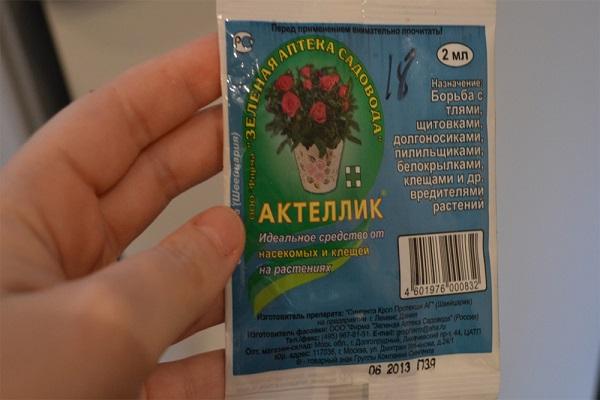
Reproduction
Grape-leaved Clematis is propagated by several methods. Each technique has its own characteristics that must be followed in order to obtain a culture with good characteristics.
Seeds
The seeds are soaked in warm water, after which they are planted in a box with a nutrient mixture. After the emergence of shoots, it is necessary to dive and plant the seedlings in separate containers. For further cultivation, the seedlings are placed in a greenhouse or on a windowsill. The seedling must be planted in open ground only after a year.
Cuttings
Shoots are selected, from which cuttings are made 10-15 cm long. Cuttings are placed in a container with "Kornevin" for a day, after which they are planted in a box with a nutrient mixture. Seedlings need to be watered regularly; they are planted in open ground the next year.
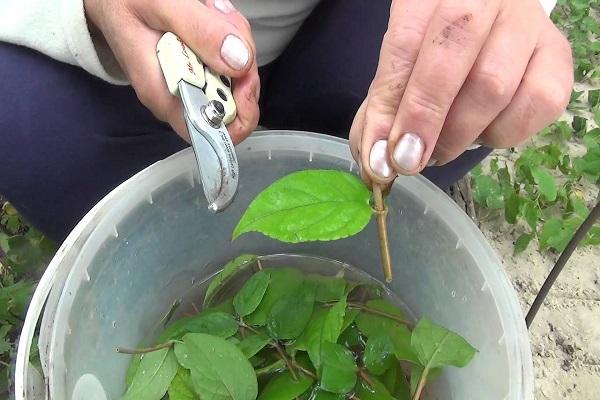
Layers
The shoot leans towards the soil and is covered with soil. The shoot must be fixed and left to germinate. This procedure can be carried out in early spring, ready-made planting material can be used in the fall.
Dividing the bush
An adult bush with an age of at least 5 years is used.A sharp shovel is used to divide the mother bush. Parts of the bush are planted in the soil and watered with warm water. Places of damage at the root must be sprinkled with ash or treated with a manganese solution. When dividing a bush, it is necessary to separate parts with soil. This is done to preserve the integrity of the roots.
Popular varieties
Grape-leaved Clematis includes varieties that have distinctive features.

Vitalba
Vitalba can grow up to 20 meters in height with ribbed shoots. Leaves are ovoid, can reach 10 cm. Inflorescences are collected in small panicles and lowered down. The flowers are white, no more than 2 cm in diameter. The middle of the flowers is yellow. The inflorescences have a faint sweet smell. The plant is resistant to diseases and adapts to a new planting site.
White snow
It grows as a large bush with a pleasant scent that spreads over a long distance. Inflorescences are white, collected in fluffy panicles. Blooms profusely throughout the summer. Vines can grow up to 4 meters long, the plant has a large number of small flowers, the diameter of which is 3 cm.
Clematis is used to decorate gardens. There are a large number of white inflorescences, due to which there is a feeling of airiness that attracts the attention of others. Clematis can be used to decorate the garden, combined with other climbing crops.



